- 1. Key Takeaways
- 2. Making a Camping Checklist
- 3. Tools for Camping and Repair Items
- 3.1. An ax or a saw
- 3.2. A multi-tool or a pocket knife
- 3.3. A mallet
- 3.4. Repair items
- 3.5. Paracord or rope
- 3.6. A headlamp or flashlight
- 4. Campsite Items
- 4.1. Tent
- 4.2. Sleeping Bags
- 4.3. Cooler and Food Storage
- 4.4. Water Containers
- 4.5. Camp Chairs and Table
- 4.6. Lighting
- 4.7. Campfire Essentials
- 5. Kitchen Essentials
- 5.1. Camp Stove
- 5.2. Cookware
- 5.3. Cleaning Supplies
- 5.4. Food & Drink
- 5.5. Utensils
- 5.6. Plates, Bowls, and Cups
- 6. Footwear and Clothing Necessities
- 6.1. Hiking Boots or Trail Shoes
- 6.2. Camp Shoes / Sandals
- 6.3. Socks
- 6.4. Pants / Shorts
- 6.5. Shirts
- 6.6. Insulating Layers
- 6.7. Outer Shell / Rainwear
- 6.8. Hat and Sunglasses
- 6.9. Optional
- 7. Hygiene Camping Supplies
- 7.1. Biodegradable Soap
- 7.2. Hand Sanitizer
- 7.3. Wet Wipes
- 7.4. Toothbrush and Toothpaste
- 7.5. Camping Towel
- 7.6. Health
- 7.7. Toilet Paper
- 7.8. Feminine Hygiene Products
- 7.9. Trash Bags
- 8. Extra Camping Must-Haves
- 8.1. Musical Instruments
- 8.2. Binoculars
- 8.3. Telescope
- 8.4. Books or E-Reader
- 8.5. Art Supplies
- 8.6. Journal and Pen
- 8.7. Yoga Mat
- 8.8. DSLR or Point-and-Shoot Camera
- 8.9. GoPro or Action Camera
- 8.10. Extra Batteries and Power Banks
- 9. Tips for Planning Your Camping Trip
- 10. Downloadable Camping Checklists for Every Camping Trip
- 10.1. A Basic Tent Camping Checklist
- 10.2. A Glamping Checklist
- 10.3. A Checklist for a Perfect Camping Trip With Your Family
- 10.4. A Camping in a Car: Checklist for an Awesome Trip
- 10.5. An RV Camping Checklist
- 10.6. A Winter Camping Checklist
- 11. Final Thoughts
- 12. FAQs
- 12.1. What are the 3 most common types of camping?
- 12.2. What is the golden rule of camping?
- 12.3. What is the 6m rule for camping?
- 12.4. What should you not keep in a tent?
- 12.5. What should you not bring camping?
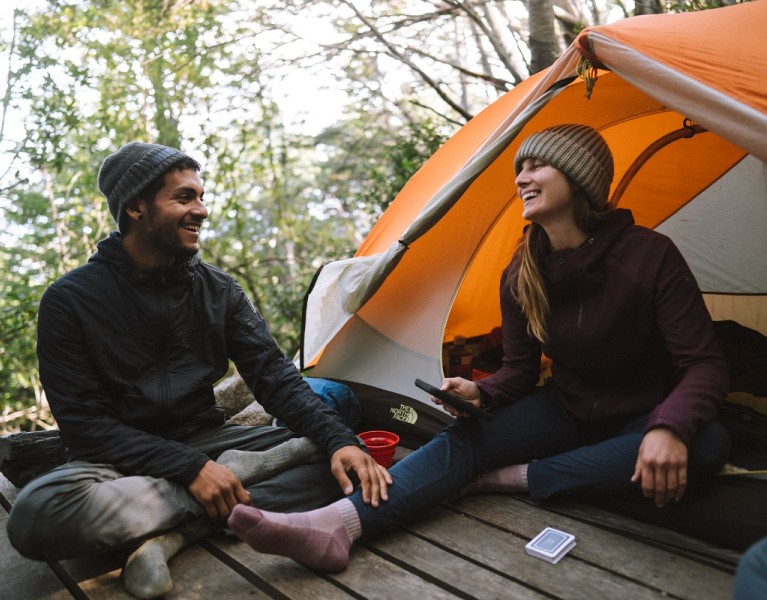
The Ultimate Camping Checklist for Must-Have Essentials
Table of Contents [Show]
We all like ticking boxes - it builds up the anticipation for the upcoming activity and gives us tiny crumbs of dopamine. Nice. What we don’t like is opening our trunk after arriving at a campsite and remembering we left that one essential camping supply in the garage (or fridge) back home.
To prevent this ever from happening, a group of scientists from Harvard University discovered a way to rewire our brains and, after decade-long testing, they came up with a simple, yet effective method to combat this situation: make a camping checklist. Just kidding.
But all jokes aside, checklists are an effective way to stay organized and keep track of completed tasks, or in our case, packed items. In this article, we’ll be covering all the camping supplies you need to pack on your next camping trip.
Since this is a lengthy article, feel free to bookmark the page and come back to it later; preferably before your camping trip. So, if you have the time, sit back, grab a cup of Joe, and let’s unpack the ultimate camping checklist together.
Note: We also have downloadable camping checklists in PDFs, for your convenience.
Key Takeaways
- Research and choose a suitable campsite that meets your preferences and needs.
- Check the weather forecast for your camping dates and pack appropriate clothing and gear.
- Create a comprehensive checklist and pack all the necessary camping gear, cooking supplies, personal items, and safety essentials.
- Familiarize yourself with the principles of Leave No Trace and practice environmental stewardship during your camping trip.
- Inform a trusted friend or family member of your camping plans, including your itinerary and expected return date.
- Prioritize safety by carrying a well-stocked first aid kit, understanding basic first aid procedures, and adhering to campfire safety protocols.
Making a Camping Checklist
As mentioned above, a camping checklist is a comprehensive list of items that helps to ensure you never have to experience the frustrating realization you forgot to pack something essential while en route to a campsite. The benefits of making a camping checklist are fivefold:
- it helps you to be well-prepared for the trip, ensuring that you have all the essential camping gear for a comfortable and safe camping experience,
- it is a visual reminder of the camping supplies and items you should pack before you go,
- it helps to reduce the stress of packing and ensures that you don't forget anything important,
- it saves time and money, as you don't have to rush to buy things that you have forgotten to pack or buy items that you could have brought from home, and
- it helps to promote responsible camping, ensuring that you leave no trace behind and adhere to camping rules and regulations, and
- Bonus: it helps avoid the aftermath of answering “Uhm, no” to the dreaded “Did you bring…” question from your significant other.
A piece of paper for peace of mind.
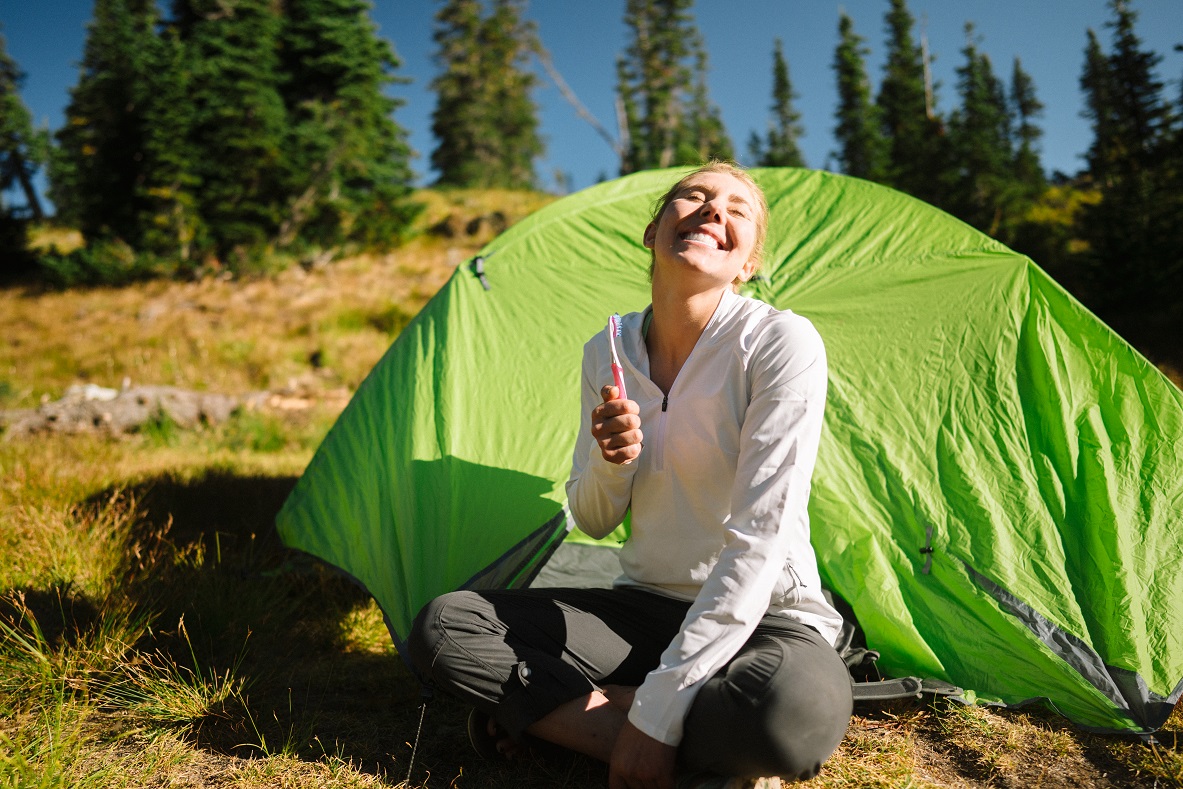
Tools for Camping and Repair Items
When preparing for a camping trip, it's essential to have the right tools and repair items on hand to ensure a smooth and enjoyable experience. Here’s a list of the most common tools to bring on any type of camping trip:
An ax or a saw
Invaluable tools. A folding saw also works as it makes it easy to store with the rest of your gear and also protects the blade. These items can help you with:
- Firewood Preparation: Used to gather and prepare firewood. An ax is particularly useful for chopping logs into smaller pieces, splitting logs, and creating kindling. It enables you to generate the necessary fuel for your campfire, providing warmth, cooking capabilities, and a cozy ambiance.
- Campsite Clearance: Used to clear vegetation or obstacles from your campsite to create a more comfortable and organized space.
- Emergency Situations: During unforeseen circumstances, an ax or a saw can assist in cutting through fallen trees or branches that may be blocking your path, creating a way out or access to necessary resources.
- Shelter Construction: When bushcrafting or survival camping, you may need to construct a shelter using natural materials like branches, logs, or tree trunks. An ax or a saw is the go-to tool for cutting and shaping these materials, allowing you to build a sturdy and protective shelter against the elements.
Always prioritize safety and be mindful of the environment when using these tools.
A multi-tool or a pocket knife
It’s considered good practice to carry a multi-tool or a pocket knife no matter the outdoor activity as it can be used for opening packages, cutting tape or string, repairing clothing or gear, and even assisting with basic tasks like opening cans or bottles. Its compact size and multiple functions make it a convenient and versatile tool for a wide range of campsite needs.
Keep in mind that certain blades may have specific regulations depending on the camping area, so it's important to be aware of any restrictions or guidelines.
A mallet
A versatile tool that assists in driving stakes, securing tarps, and performing various hammering tasks while camping. The Mjölnir ensures stability, helps with potential construction projects, and allows for efficient repairs, making it a valuable addition to your camping toolkit.
Repair items
Repair items are essential to have when camping as they allow you to address unexpected equipment failures or damage, ensuring your camping experience remains worry-free. Here are some common items found in a typical camping repair kit:
- Duct Tape: This versatile adhesive tape is used for a multitude of repairs while camping. It can temporarily patch holes or tears in tents, tarps, sleeping bags (or clothing), secure loose gear components, fix broken straps or poles, and mend various camping equipment. Duct tape is durable, easy to use, and can provide quick fixes in emergency situations.
- Patch Kits: Patch kits are specifically designed for repairing tents, sleeping pads, or air mattresses. They usually include adhesive patches that can be applied to fix punctures, leaks, or tears. These kits often work well with materials commonly found in camping equipment, allowing you to extend the lifespan of your gear and maintain its functionality.
- Spare Parts: Depending on your specific camping gear, it's considered a good practice to carry spare parts that are prone to breakage or wear and tear. This could include replacement buckles, zippers, clips, or tent stakes.
Paracord or rope
Paracord or rope is considered the most valuable item one can find in a survival situation as it is extremely versatile and has various uses. The most common uses for paracord or rope during a camping trip:
- Shelter and Tarps: Used to secure and tie down tents, tarps, or hammocks. It allows you to create sturdy anchor points and guy lines, ensuring that your shelter remains stable even in windy conditions. You can also use it to create additional support or tension for your shelter, enhancing its overall durability.
- Clothesline and Hanging Items: Used to create a clothesline to hang wet clothes or towels for drying. It's also handy for hanging lanterns, lantern bags, or other campsite decorations to illuminate and personalize your camping area.
- Securing Gear: Used to tie down equipment, such as coolers, backpacks, or camp chairs, to keep them in place and avoid them being knocked over or blown away.
- Emergency and First Aid: In emergency situations, paracord can be used for creating makeshift splints, constructing a rescue harness, or building a makeshift stretcher. Additionally, the inner strands of paracord can be used as a fishing line, sutures, or for other survival purposes.
- Repairs and Gear Adjustments: If any of your camping equipment or gear experiences a failure or needs adjustment, paracord can be used to temporarily fix or secure them. For example, you can use it to repair a broken strap, replace a broken zipper pull, or create a handle grip.
A headlamp or flashlight
A headlamp allows you to have hands-free lighting, while a flashlight offers more focused and directional illumination. Both are indispensable tools when camping in low-light conditions and during nighttime as they help with:
- Campsite Setup: When arriving at a campsite late in the day or when visibility is poor, a light source helps when you’re setting up your tent, arranging gear, and organizing your campsite. It also acts as a deterrent by warding off wildlife or providing visibility to other campers or hikers.
- Nighttime Activities: If you plan to engage in nighttime activities such as stargazing, night fishing, or wildlife observation, a headlamp or flashlight is crucial for enhancing visibility and maintaining safety. It allows you to navigate your surroundings, spot potential hazards, and enjoy outdoor activities during dark hours.
- Emergency Situations: When things get serious, a headlamp or flashlight helps you locate and access emergency supplies, signal for help, or navigate in low-light environments. A reliable light source can provide reassurance and assistance during unexpected events.
Having a dependable light source during camping provides convenience, safety, and the ability to make the most of your outdoor experience, day or night. Oh, and remember to carry spare batteries or have a power source for recharging.
Note: Here’s how to signal SOS with a flashlight - three short, three long, three short flashes of light.
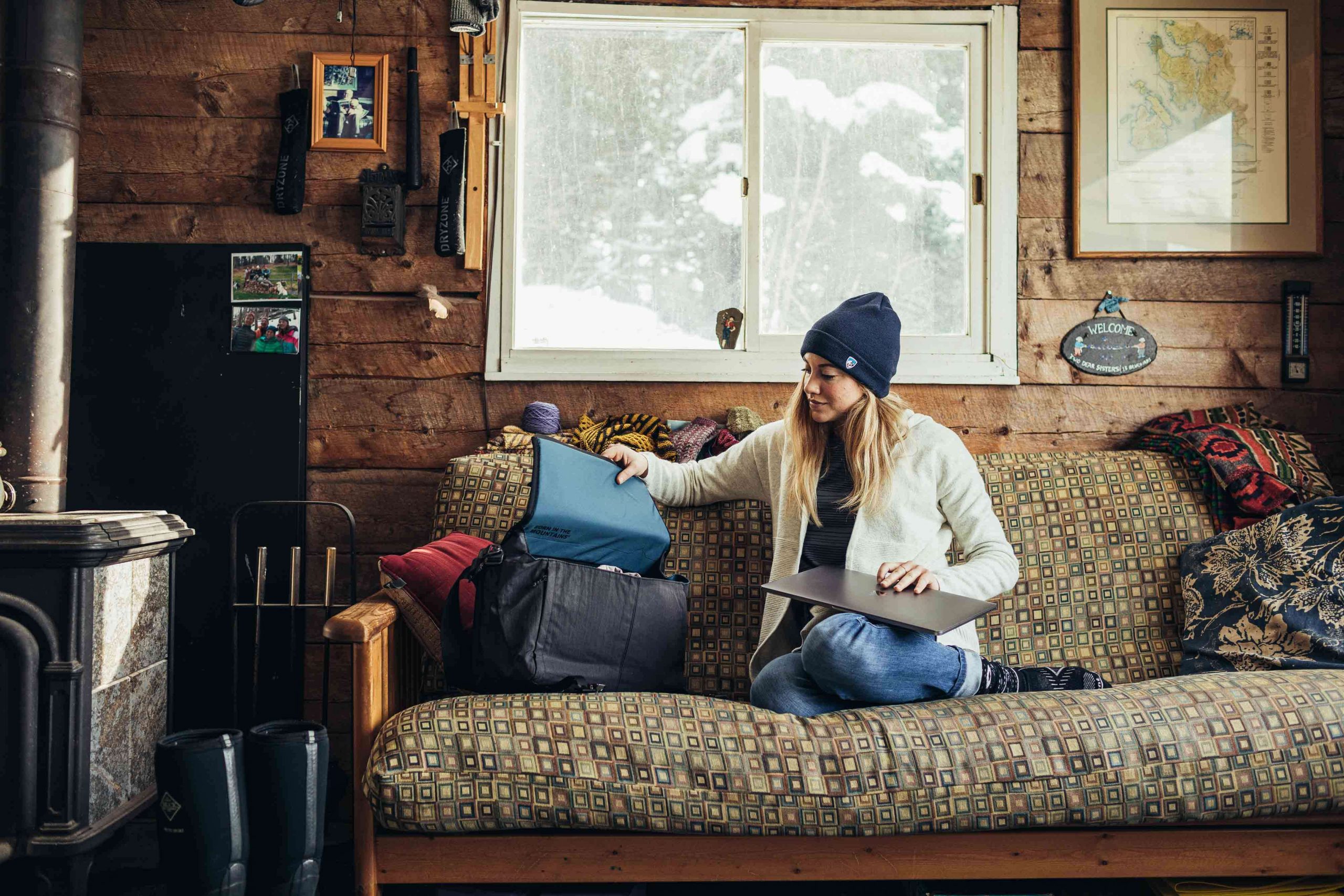
Campsite Items
List some of the campsite items necessary for any camping trip (in H3).
Not all outdoor enthusiasts spend the night in the backcountry in the same way: some love the sound of the rain hitting the tent fabric, some prefer chilling in an RV on an air mattress to a breathtaking view, while others simply enjoy the freedom that “home-on-wheels” provide. There are many other types of camping, but the list of essential items is somewhat the same:
Tent
The first thing that comes to mind when you say “camping” is sleeping in a tent in an undisclosed location (shoutout to all dispersed camping enthusiasts).
A suitable tent provides shelter and protection from the elements. Before buying a tent, choose a tent size and style that accommodates the number of campers and suits the camping environment. Some of them are actually gigantic.
Sleeping Bags
Sleeping bags provide warmth and comfort during sleep. Consider also bringing sleeping pads as they offer cushioning and insulation from the ground. Ensure that both are appropriate for the expected temperatures and terrain.
Cooler and Food Storage
A cooler helps keep food and beverages fresh and prevents them from spoiling. Storage containers, zip lock bags, bear bags, and other containers protect your food items and also prevent wildlife from picking up the scent of food.
Water Containers
The first thing you need to do is to check if your campsite has a drinking tap you can use as a water source. With this information, you can plan and pack an ample amount of water containers or a water filtration system to ensure access to safe drinking water. Staying hydrated is crucial while camping, and having enough water is necessary for cooking, cleaning, and personal hygiene.
Camp Chairs and Table
Comfortable camping chairs provide seating around the campfire, while a portable picnic table offers a convenient surface for meal preparation, dining, or playing games.
Lighting
Consider lanterns or string lights to illuminate the campsite during nighttime activities or when additional lighting is needed.
Campfire Essentials
If campfires are permitted, gather firewood, kindling, and matches or a lighter. Don't forget to bring a fire extinguisher, a firestarter (e.g., newspaper or firestarter sticks), and a fire-safe container for disposing of ashes.
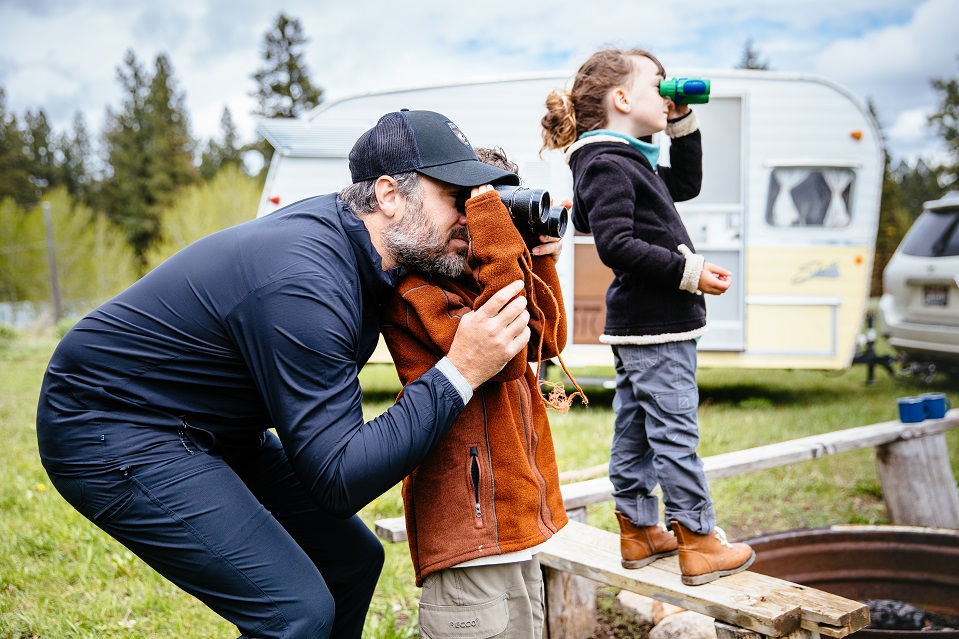
Kitchen Essentials
Preparing delicious meals, seeing the smoldering under a Dutch oven, and expressing your culinary expertise in the great outdoors is a huge part of the camping allure. Here are some kitchen essentials that will make you the Gordon Ramesy of your next camping trip:
Camp Stove
A portable camp stove is a must-have item for cooking while camping as you can use it to prepare carnivorous, omnivorous, vegetarian, and vegan camping meals. Propane or butane stoves are popular options, providing efficient heat for boiling water, cooking meals, and brewing that perfect morning cup of coffee. Look for a reliable and easy-to-use stove that suits your cooking requirements. No need to build a backcountry Hell’s Kitchen set.
Cookware
Pack a set of lightweight and durable cookware, including pots, pans, and a kettle. Opt for nesting cookware sets that save space and ensure that it’s compatible with your stove and has heat-resistant handles for safe handling. Consider additional cooking accessories such as a grill grate for open-fire cooking, a coffee percolator, or a French press for brewing coffee.
Cleaning Supplies
Don't forget to pack biodegradable dish soap, a scrub brush, and dish towels for cleaning cookware and utensils. Bring a basin or collapsible sink for washing dishes, and make sure to follow proper Leave No Trace principles by disposing of wastewater properly.
Food & Drink
Bring along some fresh produce that can last a few days without refrigeration, some non-perishable food items that are easy to store and prepare, a small container of condiments and seasonings to enhance the taste of your meals, bread or tortillas for sandwiches or wraps, and an ample supply of water for drinking and cooking.
Be mindful of proper camping food storage to prevent spoilage and keep perishable items chilled in a cooler.
Utensils
Nothing says “camping vibes” like cutlery that comes from different sets. Pack forks, knives, spoons, and serving utensils. Invest in kitchen sets designed for outdoor use, as they are made of lightweight and durable materials such as stainless steel or titanium. Don't forget a spatula or tongs for grilling and flipping food. A small compact cutting board and a knife suitable for various cutting tasks are also essential for food preparation.
Plates, Bowls, and Cups
Pack durable plates, bowls, and cups, ideally made of materials that can withstand outdoor use like enamel, stainless steel, or lightweight plastic. As with cookware, opt for stackable or collapsible designs to save space in your camping gear.
Remember to check any specific camping regulations or restrictions regarding open fires, cooking, and food storage in your camping area. With these kitchen essentials, you can whip up delicious meals and create memorable dining experiences while enjoying the beauty of the outdoors.
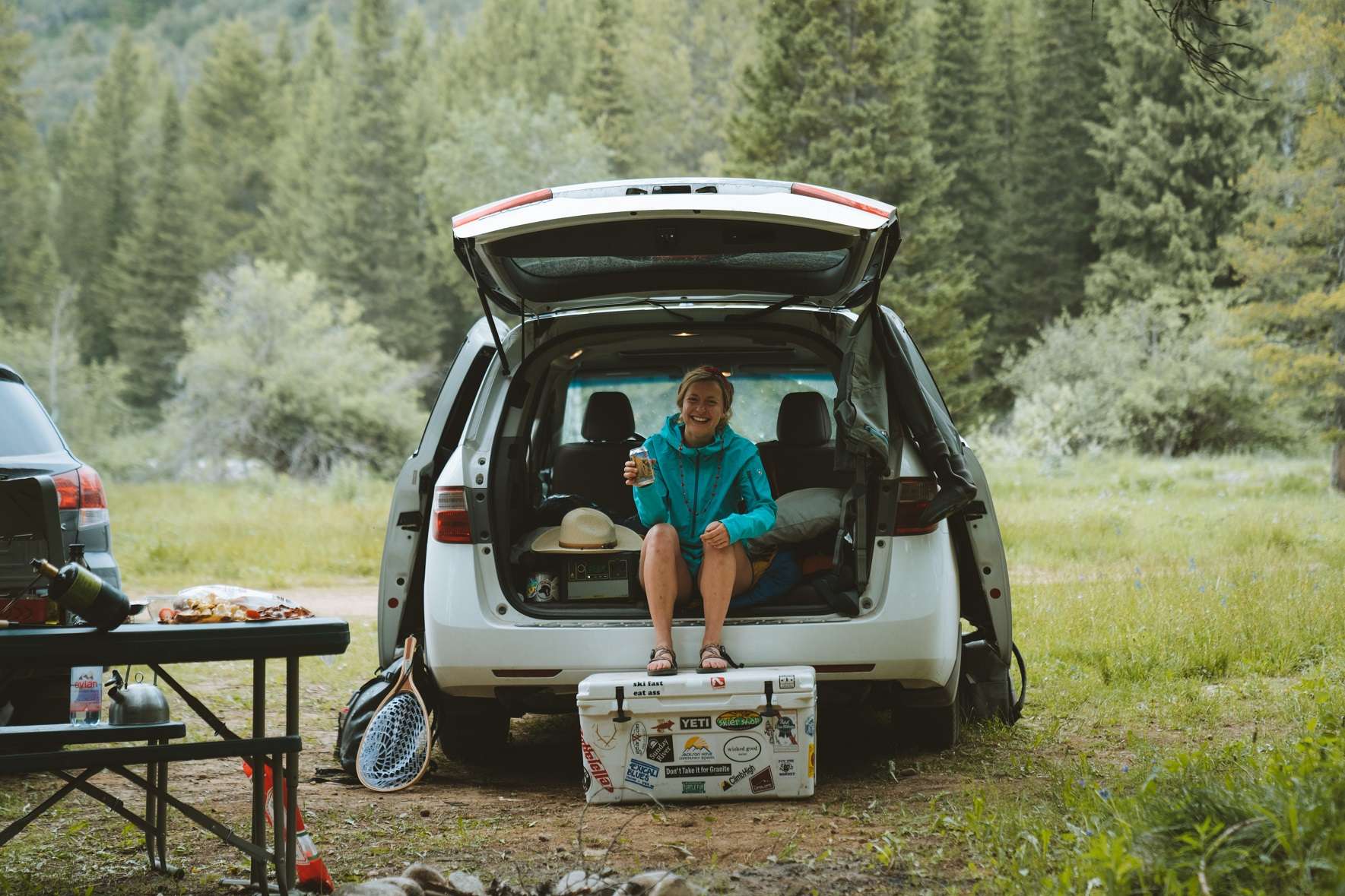
Footwear and Clothing Necessities
Unless you’re planning on walking around the campground like The Flinstones, packing appropriate footwear and clothing is essential for comfort, protection, and adapting to changing weather conditions. Here is a list of necessary footwear and clothing items to consider for your camping trip:
Hiking Boots or Trail Shoes
If you’re planning on hiking while camping, pack a pair of sturdy and comfortable footwear that provides ankle support and traction. Hiking boots or trail shoes with good grip and waterproofing are ideal for navigating various terrains.
Camp Shoes / Sandals
Bringing comfortable and breathable camp shoes, sandals, or even shower shoes to give your feet a break from hiking boots. These are convenient for moving around the campsite, relaxing, and allowing your feet to breathe.
Socks
Bring several pairs of moisture-wicking socks made of synthetic or wool materials, and a pair of funny ones just for the fun of it. Avoid wearing cotton as it retains moisture, which can lead to blisters.
Pants / Shorts
Pack durable and quick-drying hiking pants or hiking shorts for comfort and flexibility during outdoor activities. If you want the “two for the price of one deal” consider investing in convertible pants.
Shirts
Include a mix of short-sleeve and long-sleeve shirts suitable for various weather conditions. Opt for moisture-wicking fabrics that provide breathability and UV protection.
Insulating Layers
Depending on the weather, add warm insulating layers such as fleece jackets, down or synthetic insulated jackets, and thermal pants to your camping packing list. Layering allows you to adjust your clothing based on temperature changes.
Outer Shell / Rainwear
Bring a waterproof and breathable rain jacket or shell to protect against rain, wind, and unexpected weather conditions. Water-resistant pants are also useful to keep your lower body dry during heavy downpours.
Hat and Sunglasses
Depending on the season, altitude, and foliage, you might need to protect yourself from the sun's rays with a wide-brimmed hat that shades your face and neck. Sunglasses with UV protection are also crucial for eye safety and reducing glare.
Optional
Quick-drying base layers, extra sets of moisture-wicking underwear, lightweight sleepwear for the expected drops in temperature, gloves, a beanie or hat for warmth, and a buff or bandana for versatility.
There’s a huge difference between being prepared and overpacking. Consider the expected weather conditions, terrain, and duration of your camping trip when selecting your footwear and clothing. If you’re expecting temperature changes, layering is key.
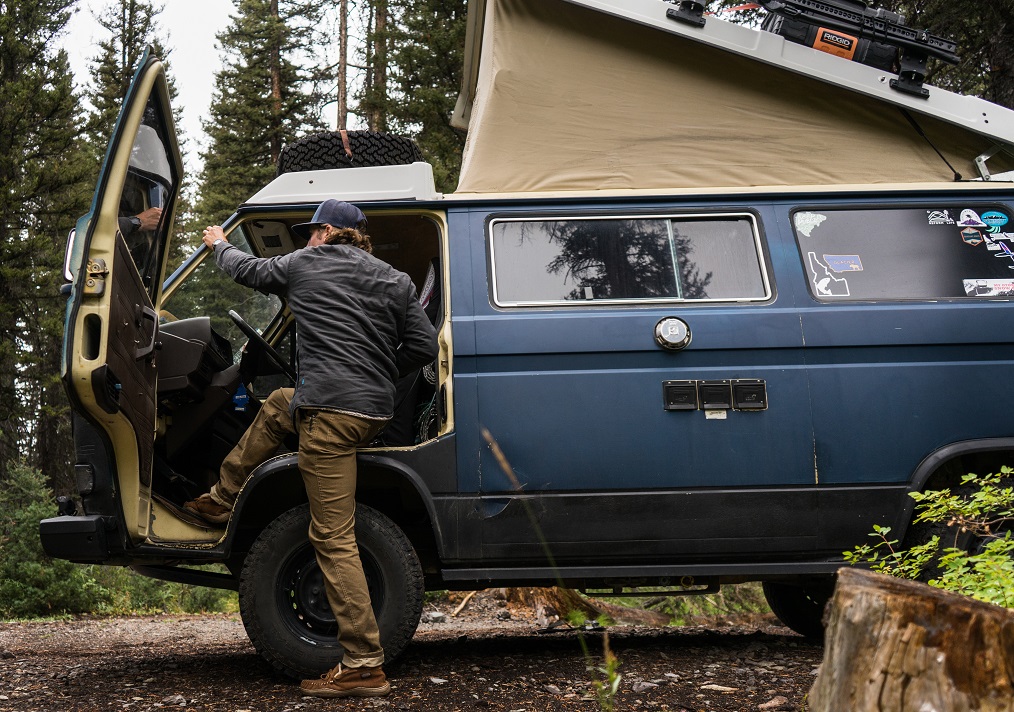
Hygiene Camping Supplies
Maintaining proper hygiene, especially on multi-day camping trips, is important for your comfort and well-being. Others will also appreciate it. Here are some hygiene supplies to consider packing for your camping trip:
Biodegradable Soap
Use it for handwashing, dishwashing, and personal hygiene. Just like with cooking supplies make sure to dispose of wastewater properly.
Hand Sanitizer
After 2019 alcohol-based hand sanitizers became something like chewing gums; at least one person in the group has it. It’s great for occasions when handwashing facilities are not readily available. It helps to keep your hands clean and free from 99.99% germs. Good luck with the remaining 0.01%. Just kidding.
Wet Wipes
Pack a supply of biodegradable wet wipes or baby wipes for quick and convenient cleaning when a shower or sink is not accessible. They are handy for refreshing your face and body or wiping off dirt from your hands.
Toothbrush and Toothpaste
If you’re planning a romantic dinner while stargazing then I suggest packing a travel-sized toothbrush and toothpaste to stay fresh. Consider using a toothbrush cover or case to keep it clean and protected.
Camping Towel
Opt for quick-drying camping towels that are compact and absorbent. They are useful for drying off after swimming, bathing, or cleaning up.
Health
When camping, it's essential to be prepared for any health-related situations that may arise. Make sure to pack a first aid kit, prescription medication, allergy medications, personal protective equipment, insect repellent, and sunscreen.
Toilet Paper
Bring an adequate supply of toilet paper or biodegradable toilet wipes. Some camping areas may not provide toilet paper, so it's important to have your own.
Feminine Hygiene Products
If applicable, bring an ample supply of tampons, pads, or menstrual cups to meet your specific needs. Please follow National Park Service precautions when storing away used tampons, pads, and towelettes.
Trash Bags
Include small, sturdy trash bags to properly dispose of waste and keep your camping area clean. Separate bags for recyclables and general waste can help with waste management.
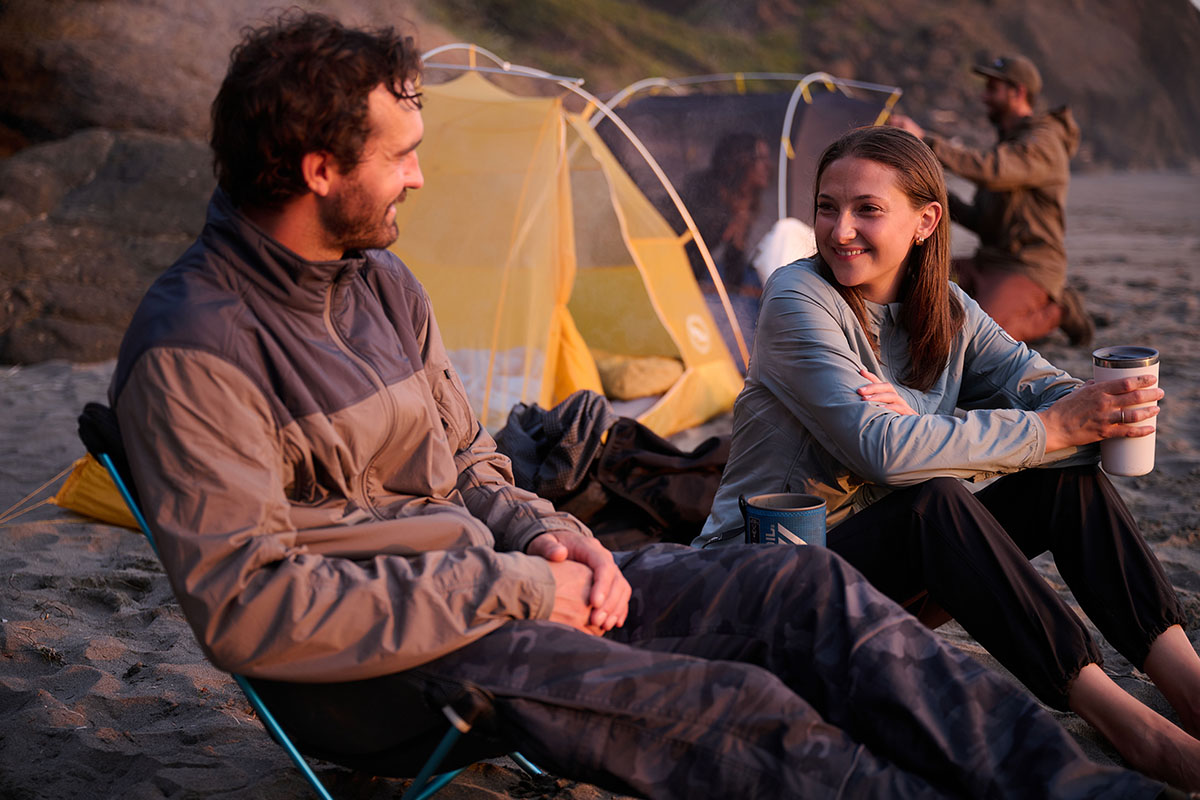
Extra Camping Must-Haves
Consider bringing items for entertainment during downtime, such as playing cards, board games, a frisbee, a football to enjoy with your camping companions or other items like:
Musical Instruments
If you enjoy playing music, consider bringing a portable instrument such as a guitar, harmonica, ukulele, or even a set of bongo drums to entertain yourself and fellow campers.
Binoculars
Explore the surrounding wildlife and take in the beauty of nature with a pair of binoculars. They are perfect for birdwatching or observing distant scenery.
Telescope
If stargazing is your passion, bring a compact telescope to enjoy the night sky and explore celestial objects during your camping trip.
Books or E-Reader
If you enjoy reading, bring along a book or an e-reader to relax and unwind while enjoying the tranquility of nature.
Art Supplies
Unleash your creativity in the great outdoors by packing art supplies like sketchbooks, paints, colored pencils, or markers. You can capture the scenic beauty or engage in nature-inspired artwork.
Journal and Pen
The tranquility we experience while camping can lead to insightful thoughts. Document your camping experiences, thoughts, or observations in a journal. Reflect on your adventures and create lasting memories through writing.
Yoga Mat
If you enjoy yoga or meditation, bring a lightweight and portable yoga mat to practice mindfulness and find tranquility in nature.
DSLR or Point-and-Shoot Camera
Capture stunning landscapes, wildlife, and memorable moments with a high-quality camera. Make sure to bring extra batteries, memory cards, and any necessary camera accessories.
GoPro or Action Camera
If you're into outdoor activities such as hiking, biking, or water sports, bring a rugged action camera like a GoPro to record your thrilling experiences.
Extra Batteries and Power Banks
Ensure you have spare batteries for your electronic devices, flashlights, and other battery-powered equipment. Portable power banks can also be handy for charging your devices while on the go.
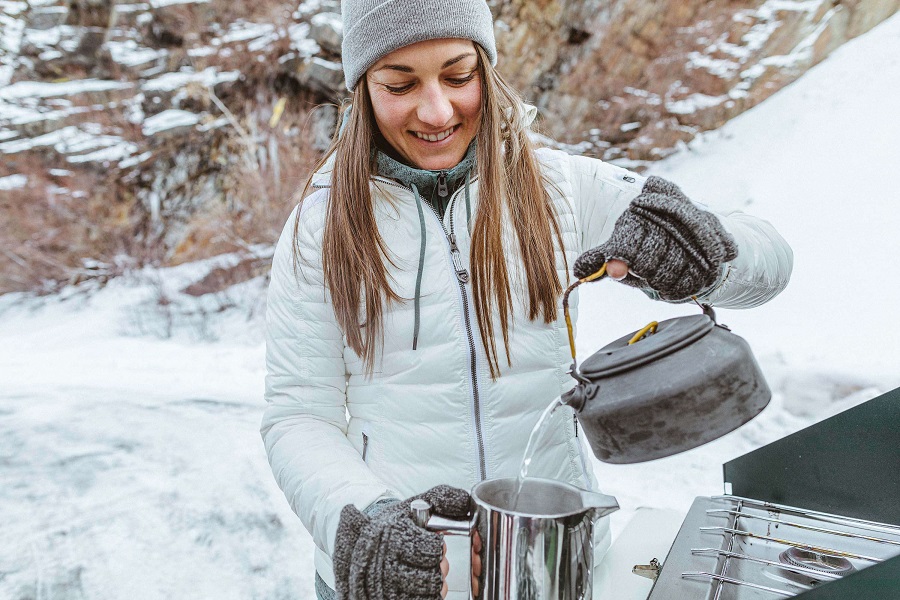
Tips for Planning Your Camping Trip
Give the reader a few tips on how to plan and prepare for a camping trip.
- Choose a Suitable Campsite - Research and select a campsite that suits your preferences and needs. Consider factors such as location, amenities, proximity to activities, and the level of difficulty if you plan to hike or engage in outdoor adventures.
- Check Weather Conditions - This will help you pack appropriate clothing, gear, and make any necessary adjustments to your plans if needed.
- Practice setting up your tent - This will familiarize you with the process and ensure you have all the necessary components.
- Plan Your Meals - Decide on your meals and make a meal plan for your camping trip. Preparing meals in advance, using pre-packaged camping meals, or pre-cutting ingredients can save time and ensure you have enough food for the duration of your trip.
- Practice Leave No Trace - Familiarize yourself with the principles of Leave No Trace, which emphasize minimizing your impact on the environment. Respect wildlife, dispose of waste properly, and leave the campsite as you found it.
- Inform Others of Your Plans - Let a trusted friend or family member know about your camping trip. Share your itinerary, expected return date, and the campsite details. This is important for safety purposes in case of any emergencies.
- Check Campsite Regulations - Familiarize yourself with the rules and regulations of the campsite you'll be staying at. Be aware of any fire restrictions, quiet hours, or specific guidelines to ensure you have a hassle-free camping experience. If campfires are allowed, follow proper campfire safety protocols. Clear the area around the fire pit, keep a bucket of water nearby, and fully extinguish the fire before leaving the campsite or going to sleep.
- Safety and First Aid - Carry a well-stocked first aid kit, familiarize yourself with its contents, and know basic first aid procedures. Additionally, bring necessary safety items such as a map, compass, flashlight, and whistle.
- Have Fun and Embrace the Experience - Slow down and enjoy the experience. Disconnect from technology if you can, take in the natural surroundings, engage in camping activities you love, and create lasting memories with your camping companions. Relax, unwind, and savor the moments of tranquility, because Monday is just around the corner.
Downloadable Camping Checklists for Every Camping Trip
Write a short opening paragraph to this segment leading to the various types of camping trips, summarizing the currently written content and maintaining the downloadable PDF for each one.
A Basic Tent Camping Checklist
Camping is a great way to get out in nature and enjoy all that it has to offer. Whether you are a beginner or an experienced camper, there are a few necessities you will need to make your adventure a successful one. This camping gear list will help you pack the basics for your next tent camping trip, no matter where you pitch your tent.
Download Basic Tent Camping Checklist
A Glamping Checklist
No matter what kind of glamorous camping trip you’re planning, there are a few essentials that you’ll need to bring with you. Some accommodations are better furnished and equipped than others, so be sure to check those amenities first.
If this is your first time hearing about glamping and you want to learn more, check out our quick guide to glamping!
A Checklist for a Perfect Camping Trip With Your Family
Camping is a great way to spend time with your family. It can be a fun and adventurous experience or a relaxing and calming one. Spending the night or two outdoors with kids is an entirely different game as the camping trip requires way more planning and way less room for error.
Download Family Camping Checklist
A Camping in a Car: Checklist for an Awesome Trip
Camping in a car can be an incredibly rewarding experience, but it's important to be prepared for the trip. First and foremost, make sure your car is in good condition and can handle the trip. Next, research car camping spots. Check the tires, brakes, and engine oil to ensure they are all up to par. Then, the car camping essentials list will help make sure you have everything you need for a great time.
Download Car Camping Checklist
An RV Camping Checklist
If you're looking for a fun and affordable summer vacation, consider camping in an RV with your friends and family. Going on an RV camping trip is a great way to experience all nature has to offer while still having all the comforts of home. You can choose from a variety of campsites, each with its own unique features and attractions.
A Winter Camping Checklist
Camping in the winter can also be a fun and unique experience, but it is important to be prepared for the colder weather. The winter camping checklist below can help you make sure you have everything you need before you go.
Download Winter Camping Checklist
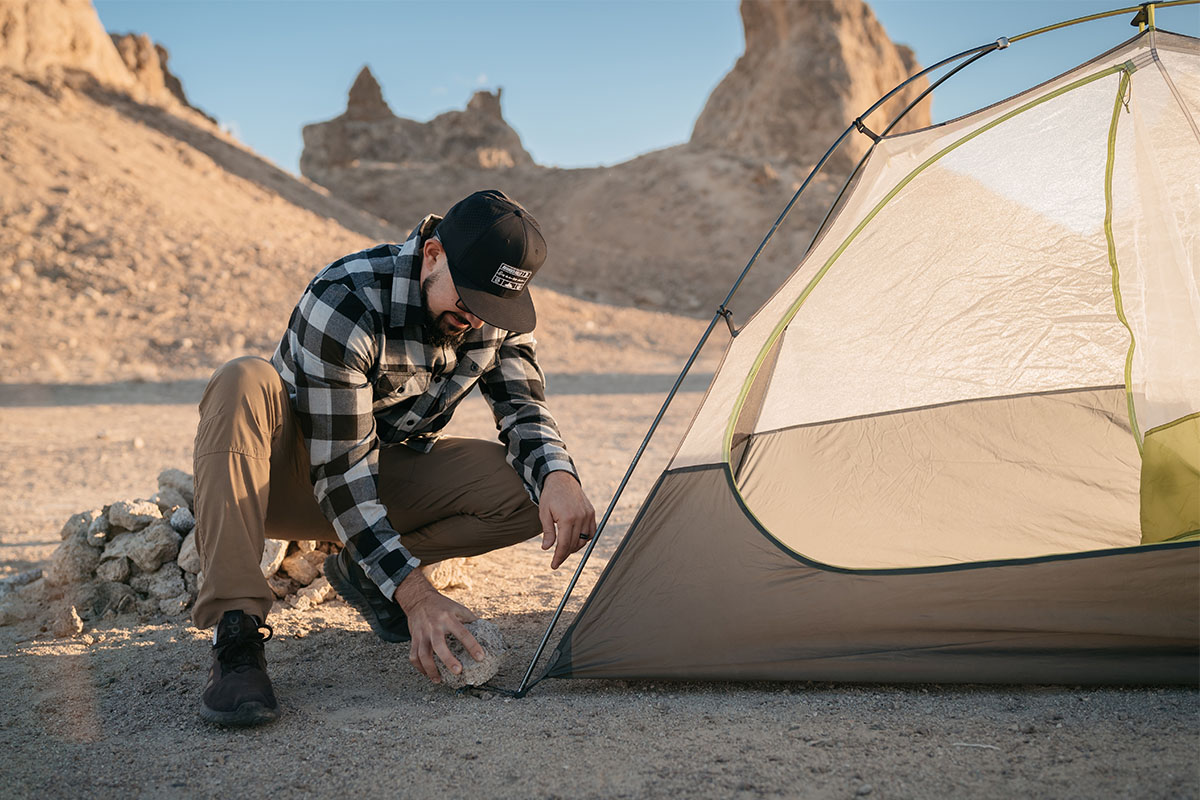
Final Thoughts
And just like that, now you know what to take on camping. Being organized, packing appropriately, and embracing the spirit of adventure and freedom will set the stage for a memorable camping experience. So, gather your camping gear, pack your bags, and embark on an outdoor adventure. Breathtaking landscapes, campfire stories, and cherished moments in nature await!
FAQs
What are the 3 most common types of camping?
Although there are many different types of camping, the most common ones are: tent camping, car camping, and glamping. But dispersed camping offers the true outdoor experience as it allows you to discover breathtaking views and beautiful natural elements that are otherwise impossible to find.
What is the golden rule of camping?
The golden rule of camping is to uphold the Leave No Trace principles. Don’t leave trash, leftover food, and litter at the campsite. Dispose of all waste properly. Try to minimize the impact of campfires. Don’t pick endangered plants. In short, leave the campsite the way you would like others to leave it to you.
What is the 6m rule for camping?
The six-meter (6m) rule for camping is an important fire safety aspect of pitching and it says that all units must be pitched six meters (20ft) from the adjacent units. So, wall-to-wall or awning distance must be 20ft / 6m if the geographical features of the campsite allow it.
What should you not keep in a tent?
Never store food in your tent and never leave it unattended. Keep all the trash and food-scented materials out. You don’t want animals foraging your campsite, especially at night. Store food in a sealed container, place it in a bag and use a paracord to hang it on a tree.
What should you not bring camping?
Don’t bring what you do not need. Don’t pack excess clothing and blankets, large pillows, glass items, too much perishable food, heating appliances that can start fires in your camp kitchen, and too many utensils. The campgrounds are not a runway so don’t bring fancy clothing and valuable jewelry


